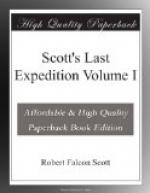The low Barrier temperatures experienced by the Crozier Party has naturally led to speculation on the situation of Amundsen and his Norwegians. If his thermometers continuously show temperatures below -60 deg., the party will have a pretty bad winter and it is difficult to see how he will keep his dogs alive. I should feel anxious if Campbell was in that quarter. [29]
Saturday, August 5.—The sky has continued to wear a disturbed appearance, but so far nothing has come of it. A good deal of light snow has been falling to-day; a brisk northerly breeze is drifting it along, giving a very strange yet beautiful effect in the north, where the strong red twilight filters through the haze.
The Crozier Party tell a good story of Bowers, who on their return journey with their recovered tent fitted what he called a ’tent downhaul’ and secured it round his sleeping-bag and himself. If the tent went again, he determined to go with it.
Our lecture programme has been renewed. Last night Simpson gave a capital lecture on general meteorology. He started on the general question of insolation, giving various tables to show proportion of sun’s heat received at the polar and equatorial regions. Broadly, in latitude 80 deg. one would expect about 22 per cent, of the heat received at a spot on the equator.
He dealt with the temperature question by showing interesting tabular comparisons between northern and southern temperatures at given latitudes. So far as these tables go they show the South Polar summer to be 15 deg. colder than the North Polar, but the South Polar winter 3 deg. warmer than the North Polar, but of course this last figure would be completely altered if the observer were to winter on the Barrier. I fancy Amundsen will not concede those 3 deg.!!
From temperatures our lecturer turned to pressures and the upward turn of the gradient in high southern latitudes, as shown by the Discovery Expedition. This bears of course on the theory which places an anticyclone in the South Polar region. Lockyer’s theories came under discussion; a good many facts appear to support them. The westerly winds of the Roaring Forties are generally understood to be a succession of cyclones. Lockyer’s hypothesis supposes that there are some eight or ten cyclones continually revolving at a rate of about 10 deg. of longitude a day, and he imagines them to extend from the 40th parallel to beyond the 60th, thus giving the strong westerly winds in the forties and easterly and southerly in 60 deg. to 70 deg.. Beyond 70 deg. there appears to be generally an irregular outpouring of cold air from the polar area, with an easterly component significant of anticyclone conditions.




